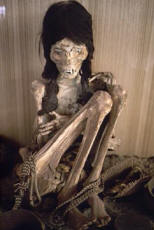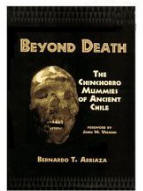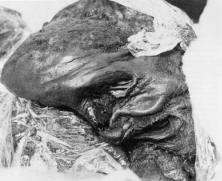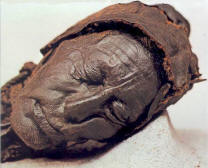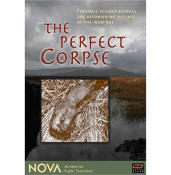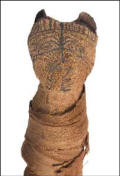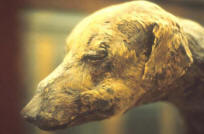 |
|||||||||||||||
|
|
Mummies can be found in many places besides the most obvious - Egypt. Below are the other mummies. Also, included are some excellent links to provide further and/or deeper research into its subject.
|
|
|||||||||||||
|
Incan Mummies
Child Mummies
Some famous Incan mummies included children. At times of a drought or a famine, a a child would be offered to the gods as a sacrificial gift. This child would be carried high onto the peak of the Andean mountains by a holy man and killed. The child would then be buried with shells, animal figurines and such. Surprisingly, five hundred years later the children's bodies were found preserved due to the freezing, dry air of the high Andean mountain range.
A mummified child
During an expedition in 1995, The Mountain Institute's anthropologists John Reinhart and Miguel Zarate discovered The Ice Maiden. Originally, they had set out to climb Mount Ampato in Peru, to search sacred sites. However, they came upon a backpack, which turned out to be an actual small body wrapped up in cloth. They tied her to Reinhart's backpack and made the trip down the mountain. She weighed about 80 pounds because her flesh was frozen and attached to her bones, not dried out. They later discovered that The Ice Maiden was 12 to 14 years old and was sacrificed to the mountain gods.
For more information about The Ice Maiden, please use the following link: http://www.mountain.org/work/andes/icemaiden.cfm
For further information on Incan mummies, please use the following link:http://www.nationalgeographic.com/inca/
Chinchorro Mummies
These mummies were found in the area between Chile and Peru. The Chinchorros may well have been the first people in the world to practice mummification. The Chinchorro people began preserving their dead 2,000 years before the Egyptians! There has been approximately 282 Chinchorro mummies discovered. Roughly half of these were preserved on purpose, whereas the other half were preserved accidentally by the region's dry coastal climate.
How were they found? While digging ditches in the city of Arica, Chile, workers discovered 96 Chinchorro mummies just under a few inches of sand!
What were their mummification methods? Their method of mummification was different than that of the Ancient Egyptians. They actually used different processes at different times in their history. The earliest methods employed sharpened objects (stones or shells) to cut the body apart, remove the organs, scrape the flesh from the bones and lastly, peel the skin off. They tied sticks or reeds to the bones to reassemble the skeleton, and stuffed the body with clay or plant fibers in place of their organs. The body was then rewrapped with its own skin and decorated with paint. Lastly, a clay mask was placed over the face.
For more information on the Chinchorro mummies, the book, Beyond Death by Bernardo Arriaza is an authority on the subject.
Bog Mummies
These mummies were preserved by a unique mummification process - they were pickled by the special conditions found in the water of a peat-moss bog. This peat-moss bog kept human bodies from decaying.
How did it work? The lack of oxygen in the water the tannic acid work together to kill the bacteria that would usually rot away a human body. It also tanned the human flesh to a soft leather.
Who were the bog people? These people were from Northern Europe. Most of them were brutally killed and sacrificed to appease the gods during the Iron Age.
Discovered Bog Mummies
Lindow Man is the name given to the bog body discovered in a peat bog at Lindow Moss in Cheshire, England. He was discovered in 1984 by commercial peat-cutters. At the time, the body was dubbed 'Pete Marsh' (a pun on 'peat marsh') by local journalists. He was preserved well enough that archeologists were able to determine how he died - a slit throat, smashed skull, and strangulation with a knotted cord! Forensic scientists determine he was about 25 - 30 years old when he died, had brown hair and a beard.
Tollund Man was discovered in 1950, named after where he was found in Holland. It was determined he was between 30 and 40 years of age when he died from a hanging. He is known for his almost peaceful expression on his face. Archeologists believe that his killers respectively closed his eyes and mouth after his sacrifice to the gods.
A documentary about the bog bodies. Central Ireland’s waterlogged landscape is no ordinary ground. Here, the moist earth halts decomposition, perfectly preserving stunning evidence of brutal ritualistic killings—corpses from the prehistoric Iron Age, over 2,000 years ago. Make no mistake, these are not skeletons or mummies, but the soft tissue and remains of people trapped in time. The perpetrators of this ancient violence are well beyond the reach of law, but there are still many fascinating secrets their victims will share if only modern science knows how to ask. NOVA is granted exclusive access to the investigation of two recently unearthed and exceedingly rare bog bodies. Enter the lab with the experts as they push archaeological forensics to its limits, aiming to enlighten how these people lived and establish how and why they died. Amazon.com
For more information on Bog mummies please use the following link:
Animal Mummies
Modern people love their pets and so did the Ancient Egyptians. They also loved them enough to make sure their beloved Fifi made it into the afterworld through the process of mummification!
The Ancient Egyptians kept many animals as household pets, including cats, dogs, monkeys, gazelles, and birds. In paintings, it can be seen that the Ancient Egyptians loved their pets dearly.
But not only in paintings does it reveal the Ancient Egyptians' love for their pets. It was a common practice for pets to be mummified and placed in their master's tomb. One Egyptian loved his dog so much that he had it mummified and wrapped in linen, to be later placed at the side of his feet in his coffin.
According to Dr. Salima Ikram, the following were the reasons the Ancient Egyptians mummified their pets:
For more information about animal mummies please use the following link:
|
|||||||||||||||
|
|||||||||||||||
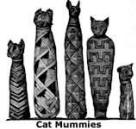

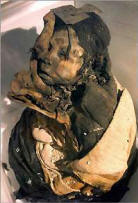
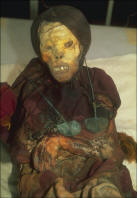 The
Ice Maiden
The
Ice Maiden